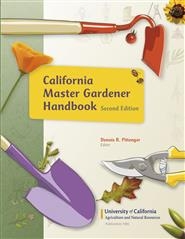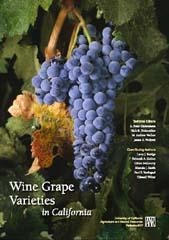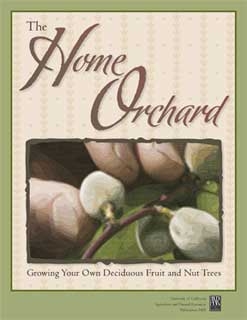
Posts Tagged: holidays
Traveling for the Holidays? Don’t Let the Bed Bugs Bite!
Do you plan to stay in a hotel during the holidays this year? If so, do you know how to look for...
Nine great gifts for your farmer or gardener this holiday season
Struggling to find that perfect gift for your agriculture expert or gardening guru this year? Well, look no further! We've assembled a great list of books and bundles on sale for you this Holiday Season! Backyard gardening, vineyard management, weed and pest identification, we have it all! All of our ebooks are on sale right now for only $9.99 as well. Give the gift of farm and garden knowledge this season!
But act quickly, these deals are going dormant on December 19!
Save 30% — the lowest price ever offered on our definitive guide to gardening in California! Whether for the serious gardener on your list or yourself, this handbook will be your go-to source for the practical, science-based information you need to sustainably maintain your landscape and garden and become an effective problem solver.
Chapters cover soil, fertilizer, and water management, plant propagation, plant physiology; weeds and pests; home vegetable gardening; specific garden crops including grapes, berries temperate fruits and nuts, citrus, and avocados. Also included is information on lawns, woody landscape plants, landscape design, information on invasive plants and principles of designing and maintaining landscapes for fire protection.
$37.00 now $25.90
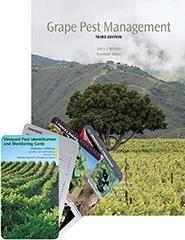
The 3rd edition of Grape Pest Management is a comprehensive, easy-to-read pest management tool; pair it with the pack of 50 sturdy, pocket-size laminated Vineyard Pest ID Cards and you're well equipped to identify and manage most common problems.
The new edition of Grape Pest Management includes several new invasive species that are now major pests. Nine expansive chapters and helpful, colorful photos throughout. The Vineyard Pest ID cards cover 41 common insects and mites, 11 diseases, 23 beneficial insects, and a variety of other disorders, weeds, and invertebrate pests. Each pest is identified by a description and close-up color photographs—244 photos in all. On the reverse of each card is a description of the various life stages and monitoring tips.
$125.00 now $87.50
This beautifully illustrated book is a "must-have" for the grower, vintner, or wine enthusiast on your list. Inside you'll find information on ripening periods for 53 varieties, ripening dates of varieties by period and growing district, detailed illustrations of grapevine structure, a glossary, and a bibliography. Each variety is highlighted by close-up photography of clusters, leaves, and leaf shoots--107 lush color photos in all.
$30.00 now $21.00
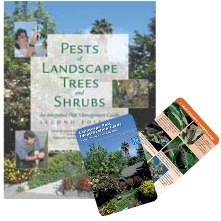
Inside Pests of Landscape Trees and Shrubs, you'll find valuable information on how to use environmentally safe, ecologically based IPM methods; landscape designs that prevent pests; how to select resistant varieties; advice on the use of less-toxic pesticides such as botanicals, oils, and soaps; and tips on planting, irrigating, and other plant-care cultural activities that help in avoiding problems.
The Landscape Pest ID Cards can be easily carried with you as a quick reference wherever you need them. Covers 80 common insects and mites, 40 diseases, 20 beneficial insects, and a variety of other disorders and invertebrate pests. Each pest is identified by a description and excellent close-up color photographs of important symptoms and life stages - 211 photos in all.
$55.00 now $38.50
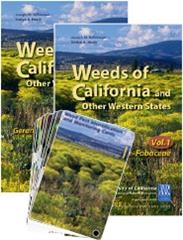
The easy-to-use 2-volume set covers 262 individual entries, and includes color photos of over 700 seeds, seedlings, flowers, and mature plants; handy identification tables; grass identification keys; and a CD containing over 3000 presentation ready photos from the book. The pocket-sized companion cards cover 48 of the most common weeds, grouped into 8 categories for easy identification held together with a sturdy rivet.
$105.00 now $75.00
Is there a backyard orchardist on your list? The Home Orchard offers an insider's look at both standard growing methods and unique innovative practices. Includes info on which species grow best in different regions and soils and how to select a variety for your region. Step-by-step information from soil preparation and planting to watering and fertilizing; pruning and grafting to thinning pest control, and harvesting.
Irrigation methods for the backyard grower are discussed and the difficult task of how often and how much water to apply is simplified.
$25.00 now $18.75
Here's your chance to scoop up the lowest price we've ever offered on this encyclopedic, yet easy-to-use 2-volume set! It c overs 262 individual entries, including a full description of 451 species and another 361 plants compared as similar species, representing 63 plant families.
Each entry describes the plant category, family name, common name, and synonyms along with a summary of the important aspects of the plant's life cycle, size, growth form, impact, method of introduction, and toxicity. You'll also find a description of the seedling, mature plant, roots and underground structures, flowers, fruits and seeds, spikelets and florets, spore-bearing structures, and post senescence characteristics for each entry.
This set also includes a CD with over 3000 photographs from the book! Perfect for use in PowerPoint presentations!
$80.00 now $56.00
Save 30% off the combined cover price of $70.00 when you purchase Pests of Landscape Trees and Shrubs and Abiotic Disorders: A Diagnostic Guide!
Pests of Landscape Trees and Shrubswill help you diagnose and manage hundreds of insect, mite, weed, plant disease, and nematode pests. You'll find valuable information on how to use environmentally safe, ecologically based IPM methods; landscape designs that prevent pests; how to select resistant varieties; advice on the use of less-toxic pesticides such as botanicals, oils, and soaps; and tips on planting, irrigating, and other plant-care cultural activities that help in avoiding problems.
Abiotic Disorders of Landscape Plants contains a wealth of information to help you diagnose disorders caused by environmental, physiological or other non-biological factors. You'll learn how to diagnose injury symptoms from a wide-ranging list of abiotic disorders including water deficit, nutrient deficiencies, salinity, pH, sunburn, herbicide, mechanical injuries, lightning, wind, and hail. You'll also learn how to develop a step-by-step diagnostic strategy.
$70.00 now $49.00
-
All of our Ebooks are $9.99 and under!
All of our Kindle books and Epubs are on sale for $9.99 or cheaper right now! Take advantage of this opportunity and fill up your digital library!
Click here for a list of all of our Kindle (MOBI) books.
Click here for a list of all of our Epub books.
To see all of our publications, visit: anrcatalog.ucanr.edu
Looking back at your leftovers

In order to keep the holidays from being spoiled, here are a few tips and tools to have at your disposal. First, check out the food storage chart to know the storage times for your food goodies. For example, cooked poultry has a shelf life of 3 to 4 days in the refrigerator, but can be extended to 2 to 6 months in the freezer. When reheating leftovers in the microwave, remember to bring them to a temperature of 165 degrees F.
If you struggle to remember how old your leftovers are, you are not alone. While lifespan varies, generally there is a four-day guideline. You can use an easy labeling system or even search for food storage phone apps to aid your memory. Iowa State University Extension mentions the 4 Day Throw away app as one possibility.
If both refrigerator and freezer space is now completely taken, but you still want to make some holiday gifts, consider dehydrating, pickling, and canning. Some fall/holiday ideas include:
- Dehydrated fruits – colorful, healthy and space saving
- Pie filling – a perfect gift for busy friends or family
- Fall Garden Relish (recipe below from So Easy to Preserve, sixth edition)
- Lemon curd – sweet, sour, rich, and buttery all at once. Yum!
Fall Garden Relish
Recipe from the National Center for Home Food Preservation
(Yields about four pint jars.)
1 quart chopped cabbage (about 1 small head)
3 cups chopped cauliflower (about 1 medium head)
2 cups chopped green tomatoes (about 4 medium)
2 cups chopped onions
2 cups chopped sweet green peppers (about 4 medium)
1 cup chopped sweet red peppers (about 2 medium)
3 ¾ cups vinegar (5%)
3 tablespoons canning salt
2 ¾ cups sugar
3 teaspoons celery seed
3 teaspoons dry mustard
1 ½ teaspoon turmeric
Combine chopped vegetables; sprinkle with the 3 tablespoons salt. Let stand 4 to 6 hours in a cool place. Drain well. Combine vinegar, sugar and spices; simmer 10 minutes. Add vegetables; simmer 10 minutes. Bring to a boil.
Pack boiling hot relish into hot jars, leaving 1/2-inch headspace. Remove air bubbles. Wipe jar rims. Adjust lids. Process 10 minutes in a boiling water bath.
If you've never preserved before, consider attending public classes held by UC Master Food Preserver Programs around the state. Find your program and get started!
Beyond New Year's resolutions: tips for good health
Oh January 1st, how I hate you. If you’re like me you’re still recovering from the month long holiday food hangover. With three months until spring and swimsuit season on the horizon, you’re feeling the pressure to lose the winter coat! As always, you make that infamous New Year’s resolution: TO LOSE WEIGHT!

“Gym membership here I come!”
“I will not touch another carb for the rest of the year!”
“No sweets ever again… after this one!”
“I’m on a new diet, I eat nothing and when I feel like I’m going to faint I eat a cube of cheese!”
Okay the last one is my favorite quote from the Devil Wear’s Prada, but working in the health field I have found that sometimes people actually think that’s a solution. We find ourselves making resolutions that eliminate entire food groups from our diets, because we think it will help us lose weight. The thing most people don’t know or realize is that sometimes the absolutes we make can be very harmful to our health, and in the long run can actually cause us to gain the weight back plus more.
So this year, let’s make an attainable, realistic goal. Here are three tips selected from www.choosemyplate.gov, to have a healthy year!
- Put a positive spin on it – instead of saying “I can’t eat any sweets at all!” try a few “I will” statements on for size:
- I will add 1 serving of fruits and vegetables to each meal.
- I will make half of my grains whole.
- I will choose water or low-fat milk more often.
- Build a healthy snack – instead of buying the expensive processed snacks, try these healthy tips:
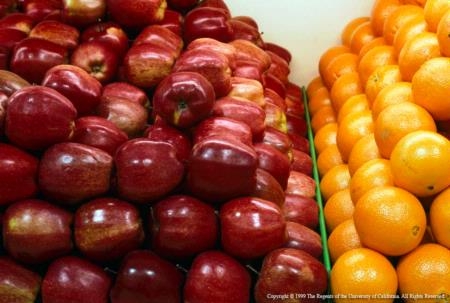 Fruit makes a great snack
Fruit makes a great snack
Combine fruit and a dairy food for the morning munchies:
- Apple and cheese
- Banana and yogurt
Combine vegetables and a protein food for a p.m. pick-me-up:
- Celery and peanut butter
- Carrots and almonds
Combining these foods will help you stay fuller longer while increasing your nutrient consumption.
- Don’t discount physical activity – being healthy isn’t about just what you eat. Adults need 30 minutes of physical activity a day and children need 60 minutes. Just because you don’t have a gym membership doesn’t mean you can’t be physically active. Remember that 30 minutes can be broken up throughout the day.
Here are some tips to increase your physical activity incrementally, without breaking the bank:
- Start a walking club with your co-workers, neighbors or friends. You’re more likely to do it if someone keeps you accountable.
- Do what you like! If you hate to run, don’t do it. There’s no use in driving yourself crazy doing something you hate. If you like to dance, then turn the radio up and have fun!
- Do stretches, exercises, or pedal a stationary bike while watching television.
Remember to always consult your physician before beginning a rigorous exercise regimen.
May your new year be full of realistic, attainable, resolutions! Keep it positive. Select healthy snacks that help you stay full longer. Get moving so you have more energy during the day. For more information and health tips visit www.choosemyplate.gov.
Wishing you all a very healthy 2012!
The party's ova
Spring is a big time of year for celebrating with a very cheap (cheep?), common, protein-rich food: the chicken egg. And because the hard-boiled egg has a special place at the Seder table and an important role in Easter morning hunts and afternoon picnics, eggs right now are selling like hotcakes. Problem is, the more eggs your market sells, the more likely you are to get them extra fresh, and consequently, the more trouble you're likely to have getting the things to peel when it's time to eat them up.
Chemistry is at the root of the egg-peeling problem: a newly laid egg has a slightly lower, more acidic pH value than the raw egg that you've stored in the refrigerator for a few days. The higher pH of the stored egg allows its white to cling less firmly to the membrane just inside the shell once it is cooked, and less cling means you can get the shell off more cleanly and easily. If you managed to plan ahead and get your eggs five or more days ahead of time this year, good for you! If you didn't, well, better luck next time. Clean-peeling or not, they'll still taste great.
There's a whole lot more to know about eggs than you might imagine—like whether you should wash eggs before you put them in the fridge (you shouldn't), what's the best way to store eggs in the fridge if you want them to last (pointy end down), and whether the refrigerator door egg rack was really such a great invention after all (it wasn't)—and a fun way to learn more is to visit a 4-H Avian Bowl competition at your local County Fair or other 4-H event.
Thanks to the guidance and commitment of UC Extension Poultry Specialist Francine Bradley, California 4-H teams have been doing very well lately in the Avian Bowl, winning first place in the national competition in eight out of the last ten years.
So next time you have a question about eggs or chickens, go find a 4-Her. Just don't ask them which came first. They get that a lot.
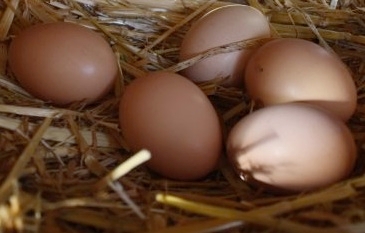
brown eggs in the straw

